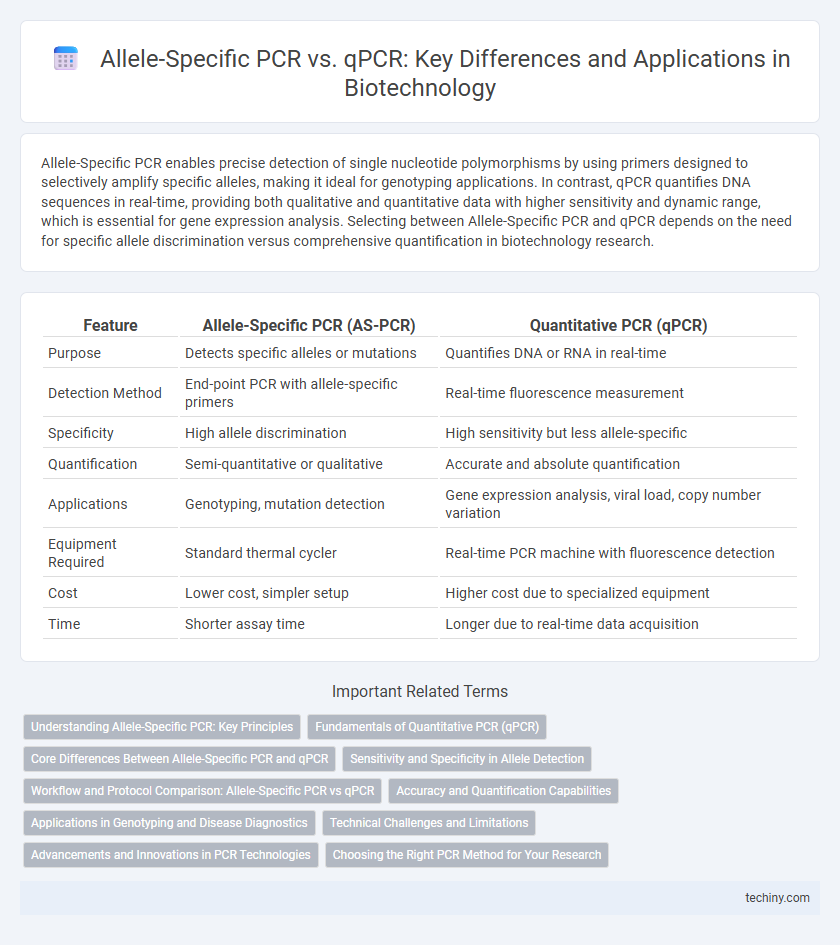Allele-Specific PCR enables precise detection of single nucleotide polymorphisms by using primers designed to selectively amplify specific alleles, making it ideal for genotyping applications. In contrast, qPCR quantifies DNA sequences in real-time, providing both qualitative and quantitative data with higher sensitivity and dynamic range, which is essential for gene expression analysis. Selecting between Allele-Specific PCR and qPCR depends on the need for specific allele discrimination versus comprehensive quantification in biotechnology research.
Table of Comparison
| Feature | Allele-Specific PCR (AS-PCR) | Quantitative PCR (qPCR) |
|---|---|---|
| Purpose | Detects specific alleles or mutations | Quantifies DNA or RNA in real-time |
| Detection Method | End-point PCR with allele-specific primers | Real-time fluorescence measurement |
| Specificity | High allele discrimination | High sensitivity but less allele-specific |
| Quantification | Semi-quantitative or qualitative | Accurate and absolute quantification |
| Applications | Genotyping, mutation detection | Gene expression analysis, viral load, copy number variation |
| Equipment Required | Standard thermal cycler | Real-time PCR machine with fluorescence detection |
| Cost | Lower cost, simpler setup | Higher cost due to specialized equipment |
| Time | Shorter assay time | Longer due to real-time data acquisition |
Understanding Allele-Specific PCR: Key Principles
Allele-Specific PCR (AS-PCR) employs primers designed to selectively amplify specific DNA alleles, enabling precise detection of single nucleotide polymorphisms (SNPs) and mutations in genomic DNA. This technique relies on primer-template complementarity at the 3' end, where a single base mismatch inhibits extension, allowing discrimination between alleles. Compared to quantitative PCR (qPCR), AS-PCR offers high specificity for genotyping but lacks the quantitative measurement of gene expression or DNA copy number provided by qPCR methodologies.
Fundamentals of Quantitative PCR (qPCR)
Quantitative PCR (qPCR) enables real-time detection and quantification of DNA by monitoring fluorescence during amplification, offering precise measurement of target sequences. Unlike Allele-Specific PCR, which uses primers designed for specific alleles to detect genetic variants, qPCR quantifies nucleic acid amounts through threshold cycle (Ct) values reflecting initial template concentration. The fundamentals of qPCR involve efficient DNA amplification, fluorescence signal generation via intercalating dyes or probe-based chemistries, and stringent reaction conditions to ensure specificity and sensitivity in quantification.
Core Differences Between Allele-Specific PCR and qPCR
Allele-Specific PCR (AS-PCR) enables precise detection of specific genetic variants by using primers designed to target single nucleotide polymorphisms (SNPs), making it ideal for genotyping applications. Quantitative PCR (qPCR) quantifies DNA amplification in real-time through fluorescent signals, allowing measurement of gene expression levels and DNA copy number variations. While AS-PCR focuses on allelic discrimination, qPCR provides quantitative data, thus serving distinct roles in genetic analysis and molecular diagnostics.
Sensitivity and Specificity in Allele Detection
Allele-Specific PCR (AS-PCR) offers high specificity in detecting single nucleotide polymorphisms by utilizing primers that selectively bind to target alleles, minimizing false positives. Quantitative PCR (qPCR) enhances sensitivity through real-time quantification and fluorescence-based detection, enabling precise measurement of allele frequency even at low abundance. While AS-PCR is ideal for distinguishing closely related alleles, qPCR provides superior sensitivity and quantitative data critical for applications such as mutation load analysis and rare allele detection in heterogeneous samples.
Workflow and Protocol Comparison: Allele-Specific PCR vs qPCR
Allele-Specific PCR (AS-PCR) uses primers designed to selectively amplify a specific allele, enabling precise mutation detection through endpoint analysis, often requiring gel electrophoresis for result visualization. Quantitative PCR (qPCR) incorporates fluorescent dyes or probes for real-time quantification of DNA, allowing continuous monitoring of amplification, which streamlines the workflow by eliminating post-PCR processing. AS-PCR protocols are typically simpler but more labor-intensive in analysis, whereas qPCR offers higher throughput and quantification accuracy with integrated data collection and automated analysis software.
Accuracy and Quantification Capabilities
Allele-Specific PCR (AS-PCR) offers high accuracy in detecting known genetic variants by using primers tailored to specific alleles, minimizing false positives in mutation identification. Quantitative PCR (qPCR) excels in quantification capabilities, enabling real-time measurement of nucleic acid levels with high sensitivity and broad dynamic range, essential for gene expression analysis and copy number variation. While AS-PCR is precise for allele discrimination, qPCR provides robust quantification, making them complementary tools in genetic and genomic studies.
Applications in Genotyping and Disease Diagnostics
Allele-Specific PCR (AS-PCR) enables precise detection of single nucleotide polymorphisms (SNPs) by targeting specific DNA variants, making it highly effective for genotyping applications in personalized medicine. Quantitative PCR (qPCR) offers real-time amplification and quantification, allowing for accurate measurement of gene expression levels and pathogen load in disease diagnostics. Both techniques complement each other in identifying genetic mutations and monitoring disease progression in clinical biotechnology.
Technical Challenges and Limitations
Allele-Specific PCR (AS-PCR) faces challenges in primer design specificity, often leading to non-specific amplification and false positives when discriminating single nucleotide polymorphisms (SNPs). Quantitative PCR (qPCR) offers more precise quantification and sensitivity, but its limitation lies in higher costs and the requirement for advanced instrumentation and fluorescence-labeled probes. Both methods require rigorous optimization to minimize amplification bias and ensure accurate allele discrimination within complex genomic samples.
Advancements and Innovations in PCR Technologies
Allele-Specific PCR (AS-PCR) offers precise detection of single nucleotide polymorphisms by utilizing primers designed for specific alleles, enhancing genetic mutation analysis. Quantitative PCR (qPCR) advances real-time quantification of nucleic acids through fluorescent probes, improving sensitivity and dynamic range in gene expression studies. Innovations like digital droplet PCR and multiplex PCR further refine allele discrimination and quantification accuracy, accelerating diagnostic and research applications in biotechnology.
Choosing the Right PCR Method for Your Research
Allele-Specific PCR offers precise detection of known single nucleotide polymorphisms with high specificity, making it ideal for genotyping and mutation analysis in targeted research. Quantitative PCR (qPCR) provides accurate quantification of nucleic acids, enabling gene expression analysis and absolute or relative quantification of DNA or RNA in complex samples. Selecting the appropriate PCR method depends on experimental goals, with Allele-Specific PCR favored for mutation discrimination and qPCR preferred for measuring gene expression levels and DNA quantity.
Allele-Specific PCR vs qPCR Infographic

 techiny.com
techiny.com